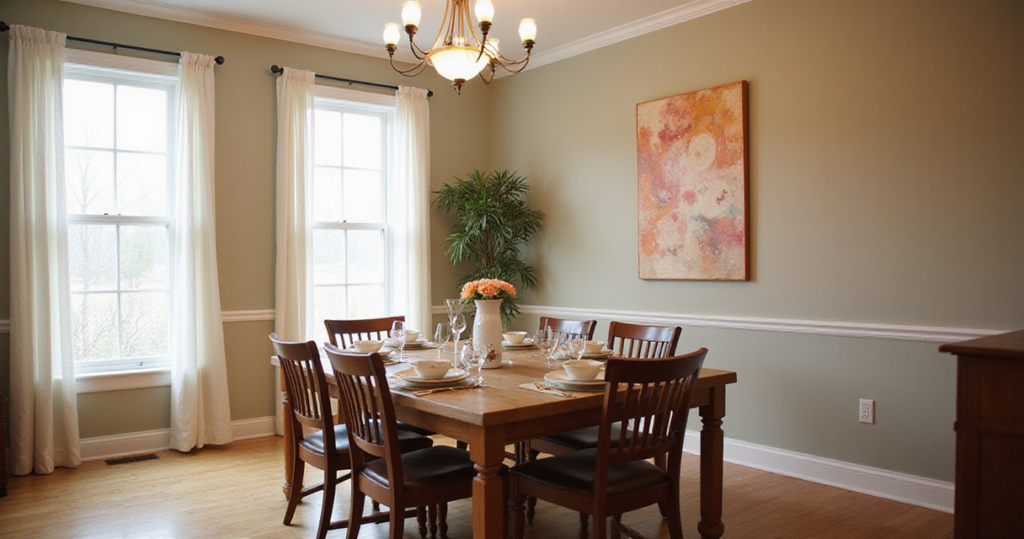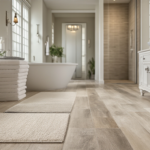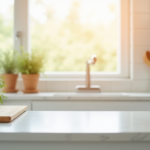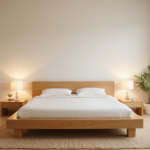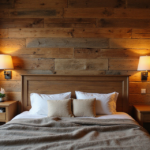The dining room holds a special place in our hearts—it’s where Sunday suppers stretch late into the evening, where holiday traditions come alive, and where everyday moments become cherished memories. Yet so often, we focus on the perfect table setting or the ideal chandelier while overlooking the canvas that frames it all: our walls.
Your dining room walls possess extraordinary potential to set the mood, define the space, and reflect your personal style. Whether you’re working with a cozy breakfast nook or a grand formal dining room, the right wall treatment can transform an ordinary space into something truly extraordinary. From the warmth of natural textures to the drama of bold color choices, each approach offers its own unique way to enhance both the beauty and functionality of your dining experience.
These 19 dining room wall ideas will guide you through a curated collection of approaches that blend timeless elegance with fresh, contemporary touches. Each suggestion has been chosen not just for its visual impact, but for its ability to create the kind of atmosphere that makes every meal feel special.
1. Create Atmosphere with Thoughtful Paint Colors
The transformative power of paint extends far beyond simple color—it’s about creating an emotional backdrop that enhances every dining experience. When selecting paint for your dining room, consider how different hues interact with natural light throughout the day and how they complement your existing furnishings. Warm terracotta tones can make intimate dinners feel especially cozy, while soft sage greens create a serene backdrop that encourages lingering conversations over coffee.

The key lies in understanding how color psychology works within your specific space. Deeper, saturated colors like navy or forest green can make a large dining room feel more intimate and sophisticated, while lighter shades help smaller spaces feel more open and airy. Consider the architectural details of your room as well—crown molding and wainscoting become more pronounced when painted in contrasting tones, adding depth and visual interest to your dining room wall ideas.
What makes this approach special is the way color becomes a foundation for everything else in the room. Once you’ve established your palette, every subsequent design choice—from artwork to table linens—can build upon this carefully chosen backdrop, creating a cohesive and intentional aesthetic.
2. Make a Bold Statement with Feature Wall Drama
A feature wall offers the perfect opportunity to introduce personality and visual weight without overwhelming your entire dining space. This approach works particularly well behind your dining table, where it can serve as a dramatic backdrop for your meals and conversations. Consider deep, moody colors like charcoal gray or rich burgundy, which create an intimate cocoon effect that makes evening dining feel especially luxurious.
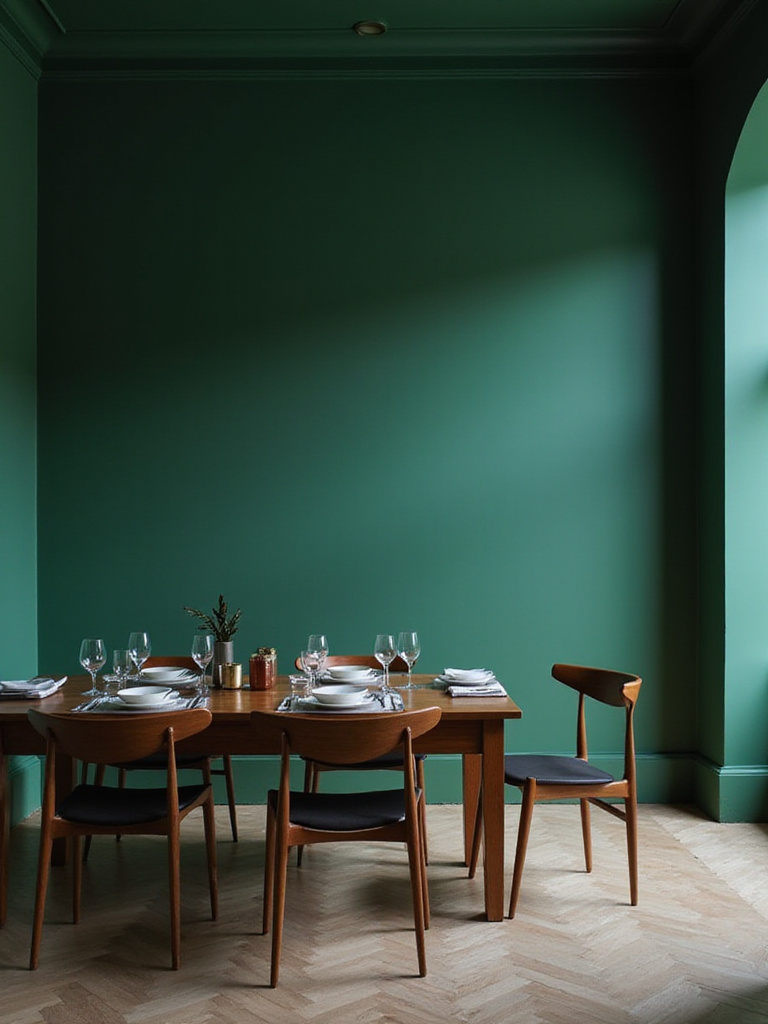
The beauty of a feature wall lies in its ability to anchor your dining room’s design while maintaining balance throughout the space. You might choose to paint one wall in a bold color while keeping the others neutral, or experiment with different finishes—perhaps a matte charcoal against walls with a subtle sheen. This contrast in both color and texture adds sophisticated depth that makes your dining room wall ideas feel intentionally curated rather than accidentally assembled.
- Color impact: Bold feature walls can make rooms feel 15-20% more intimate
- Design flexibility: Easily changed when you’re ready for a new look
- Cost effectiveness: Maximum visual impact with minimal investment
Beyond the obvious placement, consider using this for creating zones within an open-plan space, where a bold wall can help define your dining area’s boundaries.
3. Add Pattern and Personality with Designer Wallpaper
Designer wallpaper has experienced a remarkable renaissance, offering patterns and textures that simply cannot be achieved with paint alone. Today’s wallpapers range from subtle grasscloth textures that add organic warmth to bold botanical prints that bring the garden indoors. The key is selecting a pattern that complements rather than competes with your dining room’s other elements—your furniture, lighting, and artwork should all work in harmony with your wallpaper choice.

When incorporating wallpaper into your dining room, consider scale carefully. Large-scale patterns work beautifully in spacious rooms with high ceilings, while smaller, more delicate patterns suit intimate dining spaces. Textured wallpapers like linen or silk add tactile interest without overwhelming the space with busy patterns. These materials catch and reflect light differently throughout the day, creating subtle variations that keep your walls interesting from morning coffee to evening wine.
- Texture variety: From grasscloth to silk, materials add tactile dimension
- Pattern scale: Large prints for spacious rooms, delicate designs for cozy spaces
- Light interaction: Textured surfaces create dynamic shadows and highlights
The artisans’ commitment to environmental practices means many of today’s wallpapers use sustainable materials and low-VOC inks, making them beautiful choices for health-conscious homes.
4. Curate Personal Stories Through Gallery Walls
A thoughtfully arranged gallery wall transforms your dining room into a reflection of your family’s journey, interests, and aesthetic sensibilities. Unlike a single large piece, a gallery wall allows you to tell a more complex story through the interplay of different images, sizes, and frame styles. Mix family photographs with artwork you’ve collected, vintage finds from antique shops, and perhaps a few pieces created by family members to build a display that’s uniquely yours.
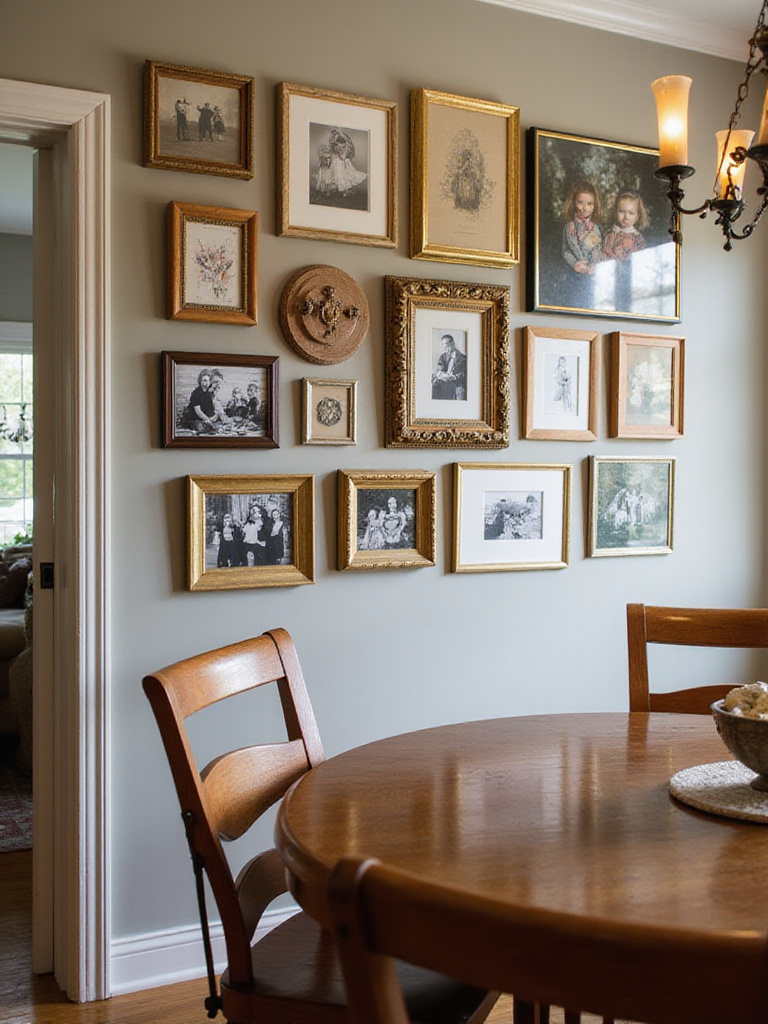
The secret to a successful gallery wall lies in creating visual balance while maintaining an organic, collected-over-time feeling. Start by laying out your pieces on the floor, experimenting with different arrangements until you find one that feels harmonious. Consider varying the heights and sizes while maintaining some common elements—perhaps all black frames, or a consistent mat color—to tie the collection together. This approach to dining room wall ideas creates conversation starters that make your dining space feel more personal and welcoming.
Planning your layout beforehand saves time and prevents unnecessary holes in your wall, while varied textures and objects beyond just framed art add depth and tactile interest to your display.
5. Amplify Light and Space with Strategic Mirrors
Mirrors possess an almost magical ability to transform the perception of space and light in your dining room. A large mirror positioned opposite a window can effectively double the amount of natural light in your space while creating the illusion of additional square footage. This technique works particularly well in urban dining rooms where natural light might be limited, or in narrow spaces that benefit from the visual expansion mirrors provide.
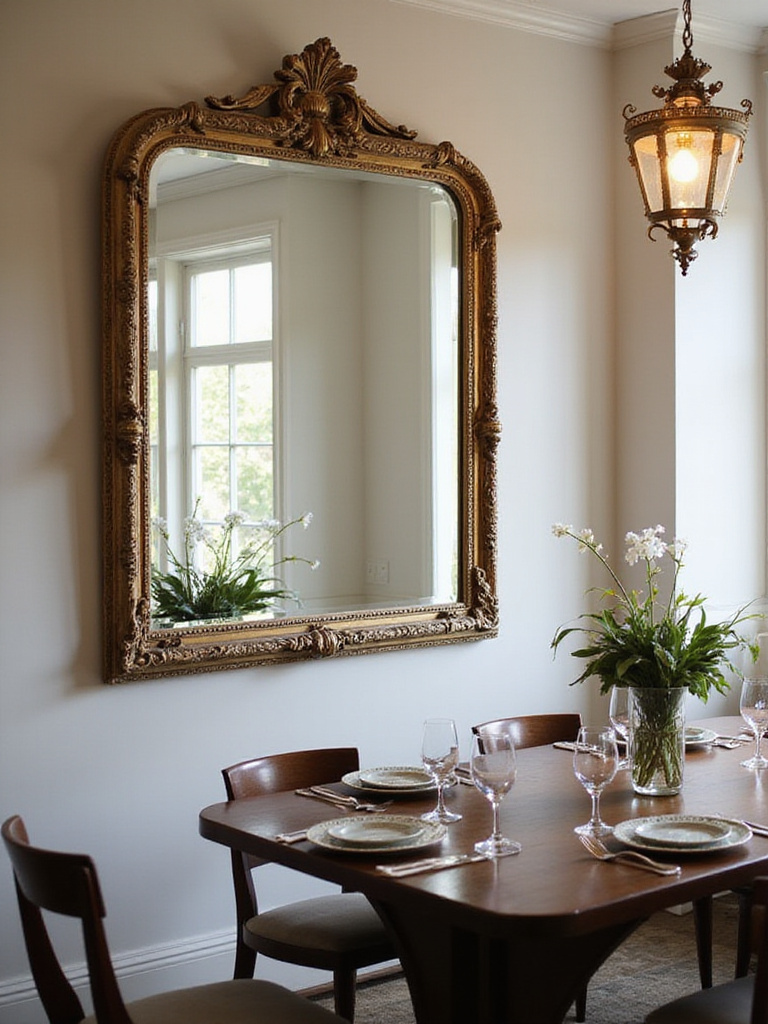
Consider the view your mirror will reflect—you want it to capture something beautiful, whether that’s a glimpse of your garden, an interesting architectural detail, or simply more of your thoughtfully designed dining room. Antique mirrors with aged glass add character and warmth, while clean-lined contemporary mirrors suit more modern spaces. The frame you choose becomes part of your room’s design story, so select something that complements your existing aesthetic while adding its own personality.
“A mirror is like adding another window to the room, especially if it’s reflecting something beautiful,” and this principle becomes especially powerful when you use mirrors to reflect your dining room’s most attractive features back into the space.
6. Combine Function and Beauty with Wall Shelving
Wall shelving in the dining room serves the dual purpose of providing practical storage while creating opportunities for beautiful displays. Open shelving allows you to showcase your favorite serving pieces, vintage glassware, or collected ceramics, turning functional items into decorative elements. The key is maintaining a balance between utility and aesthetics—your shelves should look intentionally styled rather than cluttered with everyday items.
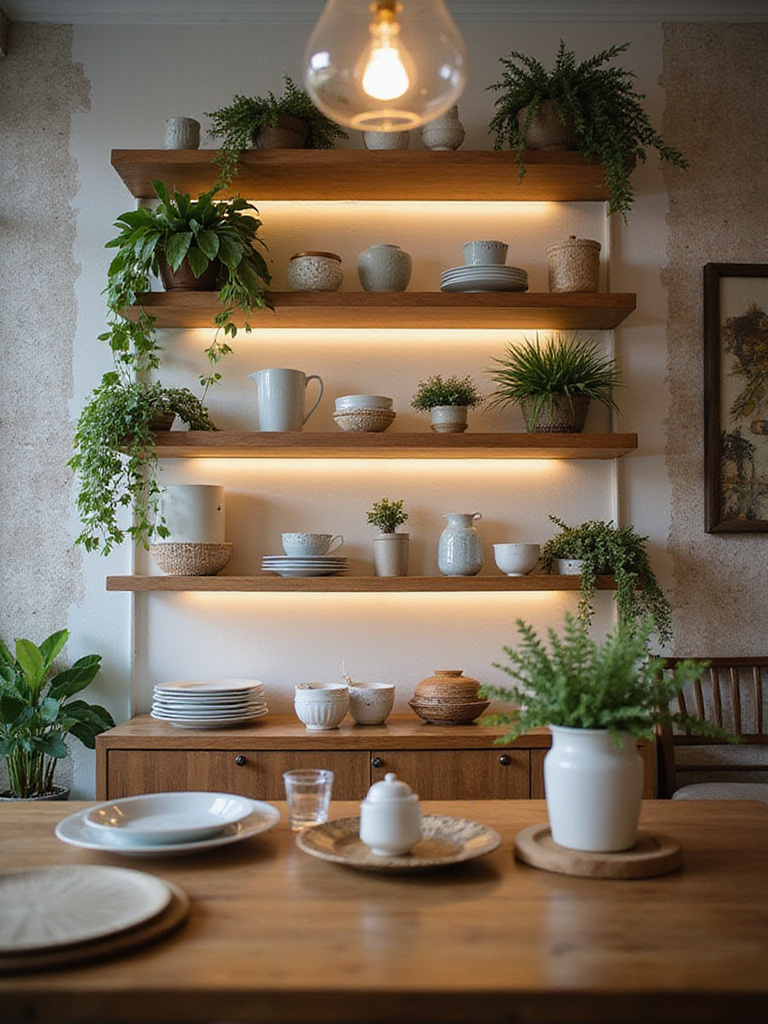
Consider the proportions of your shelving in relation to your room’s scale. In a dining room with high ceilings, tall, narrow shelving draws the eye upward and emphasizes the room’s vertical space. Lower, longer shelves work well in more intimate settings, providing display space without overwhelming the room’s proportions. Floating shelves offer a clean, contemporary look, while shelving with visible brackets can add industrial or traditional character depending on the style you choose.
- Display strategy: Mix functional items with purely decorative pieces
- Seasonal flexibility: Easy to update displays for holidays or seasons
- Storage efficiency: Maximizes vertical space without floor footprint
The unexpected pairing that always works is combining books with ceramics and small plants, creating displays that feel both lived-in and carefully curated.
7. Add Architectural Interest with Classic Wainscoting
Wainscoting brings instant architectural character to any dining room, creating the impression of custom millwork and historical detail. This treatment works particularly well in dining rooms because it provides both visual interest and practical protection against chair backs and daily wear. The horizontal line created by wainscoting can make a room feel more spacious by drawing the eye around the room’s perimeter, while the added texture creates depth and sophistication.
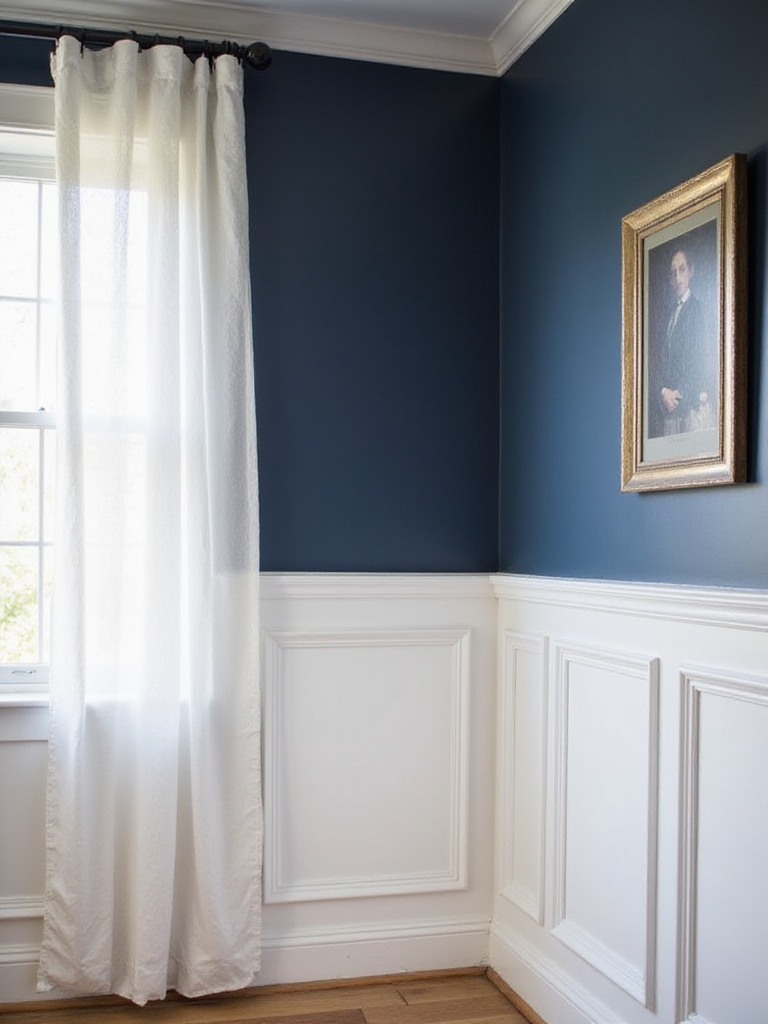
Traditional raised-panel wainscoting suits formal dining rooms, while simpler Shaker-style panels work beautifully in more casual settings. The height of your wainscoting affects the room’s proportions—lower wainscoting (around 32 inches) makes ceilings appear higher, while taller applications create a more dramatic, formal feeling. Consider painting the wainscoting and upper wall in different tones of the same color family for a sophisticated monochromatic look, or create contrast with crisp white wainscoting against deeper wall colors.
What makes this design special is the way it creates visual weight at the bottom of the room while allowing your dining room wall ideas to feel grounded and intentional rather than top-heavy.
8. Create Modern Appeal with Board and Batten
Board and batten paneling offers a fresh take on traditional wall treatments, bringing clean lines and contemporary appeal to your dining room. This technique involves installing vertical boards (battens) over a base panel, creating shadow lines that add depth and visual texture. The result feels both modern and timeless, working equally well in farmhouse-style homes and sleek contemporary spaces.
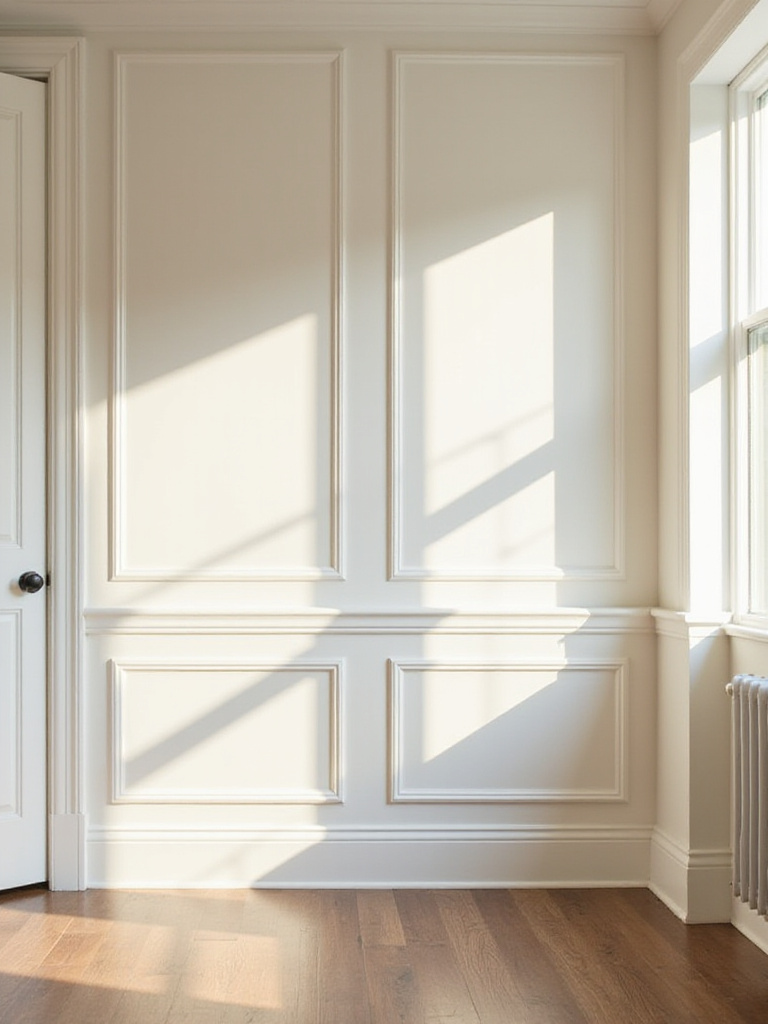
The beauty of board and batten lies in its versatility—you can install it at any height, from a traditional wainscoting height to dramatic floor-to-ceiling applications. Painting the entire treatment in one color creates a sophisticated, monochromatic look, while contrasting the battens with the base creates more dynamic visual interest. The vertical lines naturally draw the eye upward, making your dining room feel taller and more spacious.
Consider the spacing between your battens carefully—wider spacing feels more relaxed and casual, while narrower spacing creates a more formal, traditional appearance. This attention to proportion ensures your board and batten enhances rather than overwhelms your dining room’s existing character.
9. Bring Warmth with Natural Shiplap
Shiplap brings an organic warmth to dining rooms that’s difficult to achieve with other materials. The horizontal lines create a sense of movement and rhythm across your walls, while the natural wood grain adds texture and visual interest. Whether you choose to paint your shiplap or leave it natural, this treatment adds a layer of architectural detail that makes your dining room feel more finished and intentional.
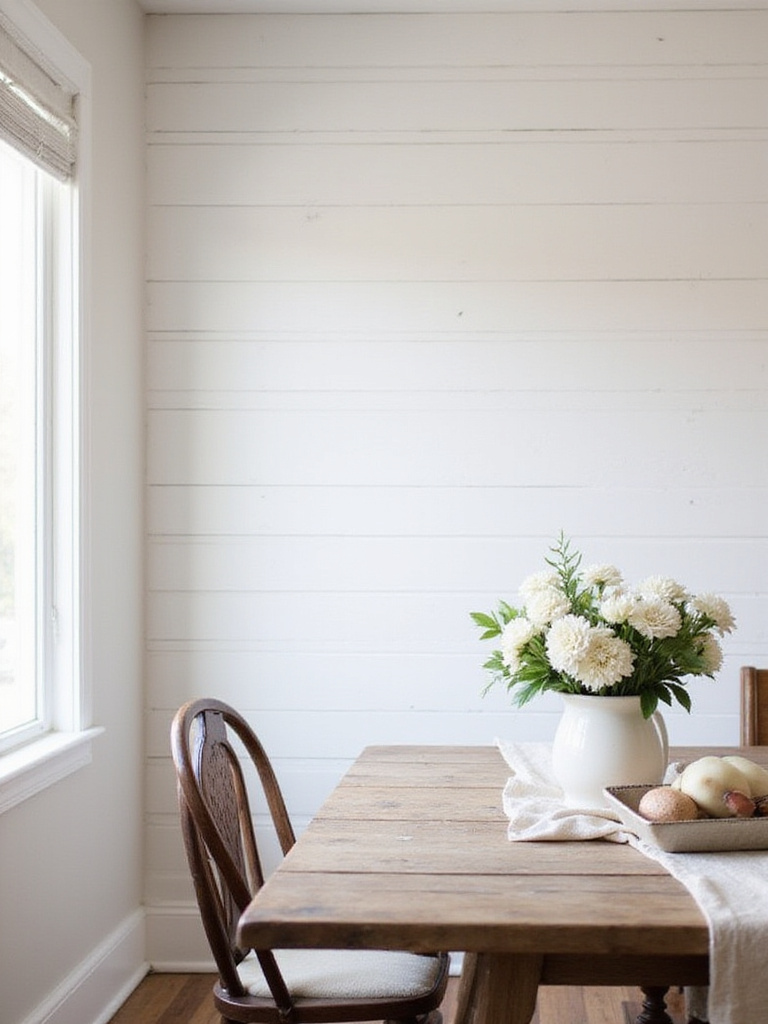
The key to successful shiplap installation lies in maintaining consistent spacing and ensuring perfectly level lines. Even small variations become noticeable across a large wall surface, so careful measuring and installation are essential. Consider the width of your shiplap boards in relation to your room’s scale—wider boards suit larger rooms, while narrower boards work better in more intimate spaces. White or cream-painted shiplap creates a bright, coastal feeling, while natural wood tones bring rustic warmth.
- Installation precision: Level lines are crucial for professional appearance
- Board width: Match scale to room size for proper proportions
- Finish options: Paint for brightness, natural stain for warmth
The heritage technique gets a contemporary update through careful attention to proportion and finish, making this classic treatment feel fresh and current.
10. Command Attention with Oversized Art
A single, substantial piece of art can transform your dining room more dramatically than any collection of smaller pieces. Oversized art creates an immediate focal point that anchors your dining space and provides a sophisticated backdrop for your meals. The key is selecting a piece that complements your room’s color palette while adding personality and visual weight to the space.
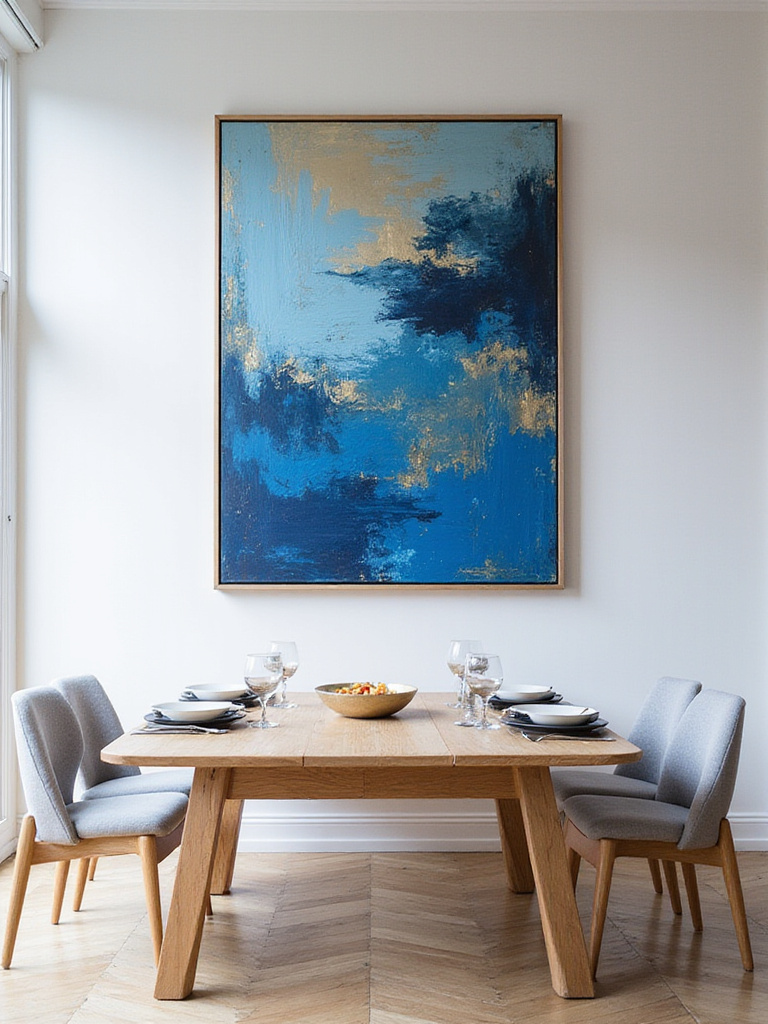
When choosing oversized art for your dining room, consider both the physical scale and the emotional impact. A large abstract painting in soft, muted tones creates a calming backdrop for intimate dinners, while a bold, colorful piece energizes the space and encourages lively conversation. Photography, textiles, and mixed-media pieces all work beautifully at this scale, offering different textures and visual experiences.
The positioning of your oversized art is crucial—it should be hung at eye level when seated, typically with the center of the piece about 57 inches from the floor. This ensures that diners can comfortably appreciate the artwork throughout their meal, making it an integral part of the dining experience rather than just wall decoration.
11. Enhance Acoustics with Fabric Wall Art
Fabric wall art serves a dual purpose in dining rooms, providing visual interest while improving the acoustic quality of your space. Hard surfaces like wood floors, glass windows, and painted walls can create echo and make conversation difficult, especially during lively gatherings. Fabric art absorbs sound waves, creating a more intimate and comfortable environment for dining and conversation.
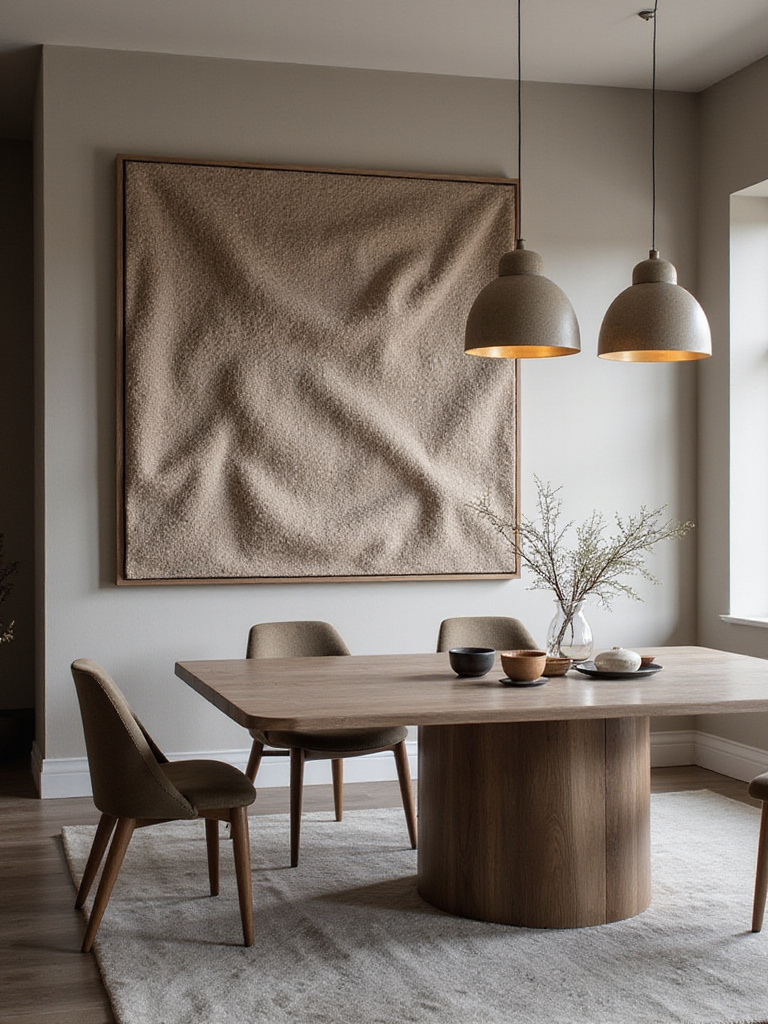
Choose fabrics that complement your dining room’s color scheme while providing the texture and visual weight you desire. Woven textiles, tapestries, and framed fabric panels all work beautifully, offering different levels of sound absorption and visual impact. Consider the scale of your fabric art in relation to your room—larger pieces provide more acoustic benefit while creating stronger visual statements.
The mounting method affects both the appearance and acoustic performance of fabric art. Pieces mounted with an air gap between the fabric and wall provide better sound absorption, while stretched canvas mounting creates a more polished, gallery-like appearance. This thoughtful approach to dining room wall ideas demonstrates how functional solutions can also be beautiful ones.
12. Express Creativity with Hand-Painted Murals
A custom mural transforms your dining room into a truly unique space that reflects your personal vision and artistic sensibilities. Unlike wallpaper or prints, a hand-painted mural is created specifically for your space, taking into account your room’s proportions, lighting, and existing design elements. This bespoke approach ensures that your mural enhances rather than competes with your dining room’s other features.

The subject matter for your mural should reflect both your personal interests and the mood you want to create in your dining space. Soft, naturalistic scenes create a serene backdrop for quiet meals, while bold, abstract designs energize the space and encourage lively conversation. Consider how the mural will look under different lighting conditions—both natural daylight and artificial evening light—to ensure it remains beautiful throughout the day.
Working with a skilled muralist allows you to achieve effects that would be impossible with other wall treatments. Trompe-l’oeil techniques can create the illusion of architectural details or expanded space, while abstract approaches can introduce color and movement in ways that complement your existing furnishings perfectly.
13. Add Character with Faux Brick Veneer
Faux brick veneer brings the warmth and character of exposed brick to your dining room without the structural challenges of real masonry. Modern faux brick options are remarkably realistic, offering the texture and visual weight of authentic brick while remaining lightweight and easy to install. This treatment works particularly well as an accent wall, creating a focal point that adds both texture and color to your dining space.
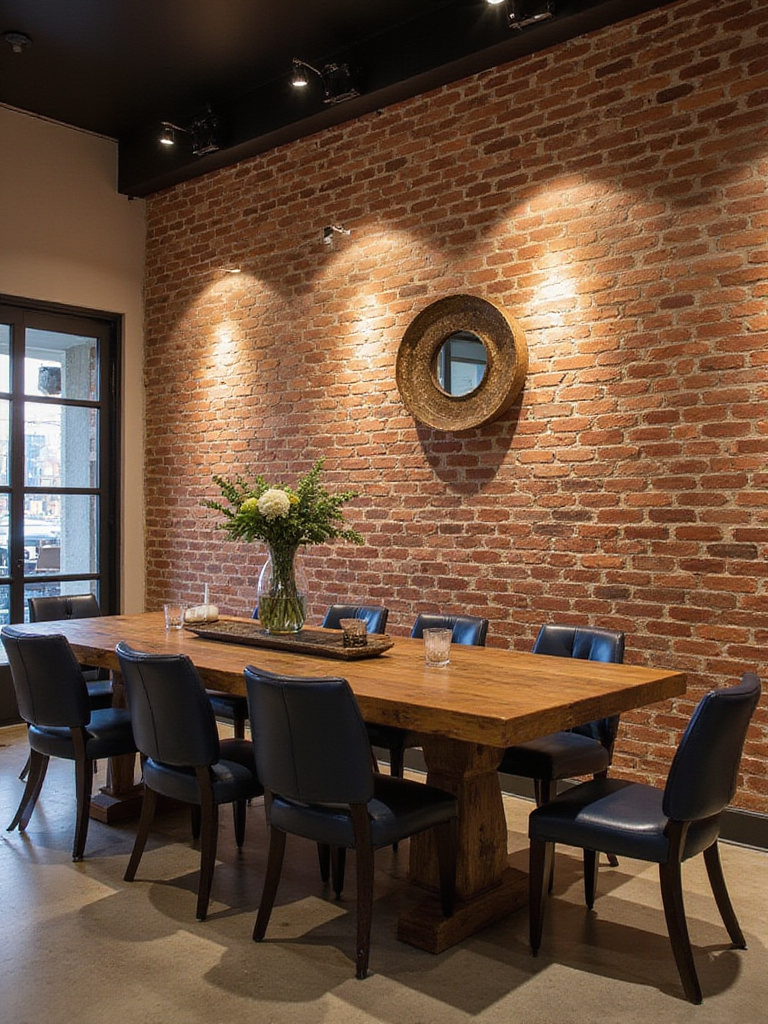
The color and style of your faux brick should complement your dining room’s existing palette and aesthetic. Whitewashed brick creates a bright, cottage-like feeling, while darker, more weathered options add industrial or rustic character. Consider the mortar color as well—lighter mortar creates more contrast and definition between individual bricks, while darker mortar creates a more subtle, blended appearance.
Installation techniques vary depending on the specific product you choose, but most faux brick veneer systems are designed for DIY installation. Proper surface preparation ensures good adhesion and a professional-looking result, while careful attention to pattern variation prevents the artificial appearance that can result from too-regular installation patterns.
14. Create Ambiance with Integrated Sconces
Wall-mounted sconces provide both functional lighting and decorative interest, creating layers of illumination that enhance your dining room’s ambiance. Unlike overhead lighting alone, sconces add visual interest at eye level while providing the warm, intimate lighting that makes dining spaces feel welcoming and comfortable. This approach to lighting allows you to create different moods for different occasions, from bright task lighting for family meals to soft ambient lighting for entertaining.

The style of your sconces should complement your dining room’s overall aesthetic while providing the type of light you need. Traditional sconces with fabric shades create soft, diffused light, while contemporary metal fixtures provide more directed illumination. Consider installing dimmer switches to give you complete control over the lighting levels, allowing you to adjust the ambiance throughout the day and for different occasions.
- Lighting layers: Sconces add mid-level illumination between overhead and table lighting
- Style variety: From traditional to contemporary, options suit every aesthetic
- Dimming capability: Essential for creating appropriate ambiance
Professional stylists approach this by first considering the room’s primary functions, then selecting sconces that enhance both the practical and aesthetic aspects of the space.
15. Encourage Interaction with Chalkboard Walls
A chalkboard wall transforms part of your dining room into an interactive canvas that can adapt to your family’s changing needs and interests. This playful approach to dining room wall ideas works particularly well in casual dining spaces where families gather for everyday meals. The chalkboard surface can display weekly menus, shopping lists, children’s artwork, or seasonal decorations, making your dining room feel more dynamic and personalized.

The key to a successful chalkboard wall lies in proper surface preparation and high-quality chalkboard paint. Multiple thin coats create a smoother surface than fewer thick coats, resulting in better erasability and a more professional appearance. Consider the size and placement of your chalkboard wall carefully—it should be accessible for writing but not so prominent that it dominates the entire room.
Framing your chalkboard wall with molding or painting it within a defined area helps integrate it into your dining room’s overall design. This approach prevents the chalkboard from feeling like an afterthought while maintaining the sophisticated appearance of your dining space.
16. Maximize Efficiency with Built-In Buffet Storage
Custom built-in buffet storage transforms an underutilized wall into a highly functional and beautiful focal point. This approach maximizes your dining room’s storage capacity while maintaining clean lines and a cohesive appearance. Built-in storage can be designed to accommodate your specific needs, from wine storage and serving piece organization to display areas for your favorite decorative objects.
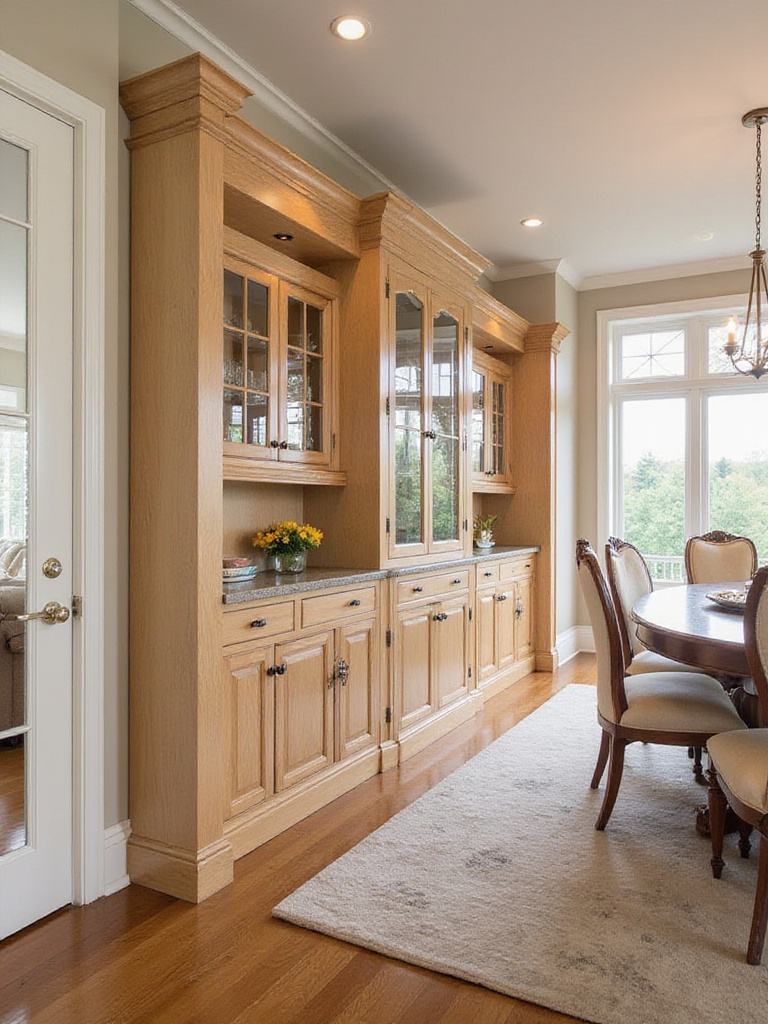
The design of your built-in storage should complement your dining room’s architectural style while providing the functionality you need. Traditional raised-panel doors suit formal dining rooms, while sleek, handleless designs work well in contemporary spaces. Consider incorporating a mix of open and closed storage—closed cabinets hide everyday items while open shelving provides display opportunities for beautiful serving pieces and decorative objects.
Lighting within built-in storage adds both functionality and visual appeal. LED strip lighting or small puck lights illuminate the contents of glass-front cabinets while creating ambient lighting that enhances your dining room’s overall atmosphere. This attention to detail transforms practical storage into a beautiful design feature.
17. Improve Comfort with Acoustic Panels
Acoustic panels address the often-overlooked issue of sound quality in dining rooms, creating a more comfortable environment for conversation and dining. Hard surfaces common in dining rooms—wood floors, large windows, and painted walls—can create echo and reverberation that makes conversation difficult, especially during larger gatherings. Strategically placed acoustic panels absorb sound waves, creating a more intimate and comfortable acoustic environment.
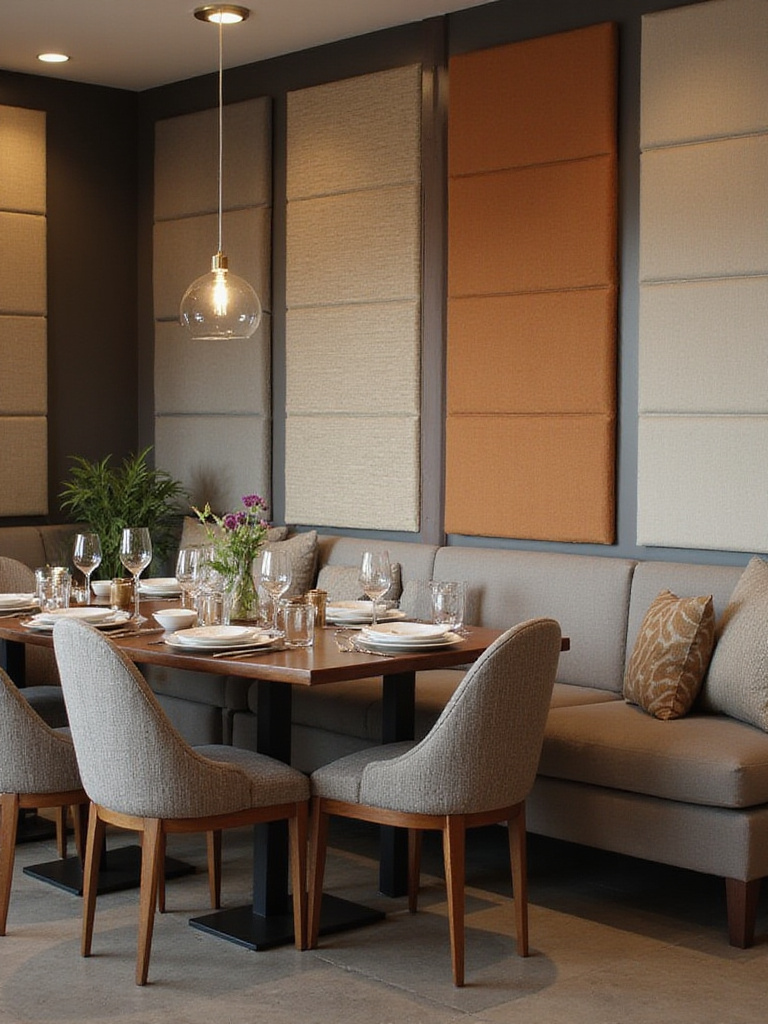
Modern acoustic panels are available in a wide range of styles and colors, allowing you to address sound issues without compromising your dining room’s aesthetic. Fabric-wrapped panels can be custom-covered in materials that complement your existing decor, while wood-slat panels add natural texture while providing acoustic benefits. Some panels are designed to look like artwork, combining sound absorption with visual appeal.
The placement of acoustic panels affects both their performance and appearance. Panels work most effectively when placed on walls opposite hard surfaces or in areas where sound reflections are most problematic. This strategic approach ensures maximum acoustic benefit while maintaining your dining room’s visual balance.
18. Connect with Nature Through Living Plant Walls
A living plant wall brings the vitality and beauty of nature directly into your dining room, creating a stunning focal point that changes and evolves over time. This biophilic approach to dining room wall ideas not only provides visual interest but also improves air quality and creates a more relaxing, natural environment for dining. The gentle movement of leaves and the fresh scent of growing plants add sensory richness that static wall treatments cannot match.
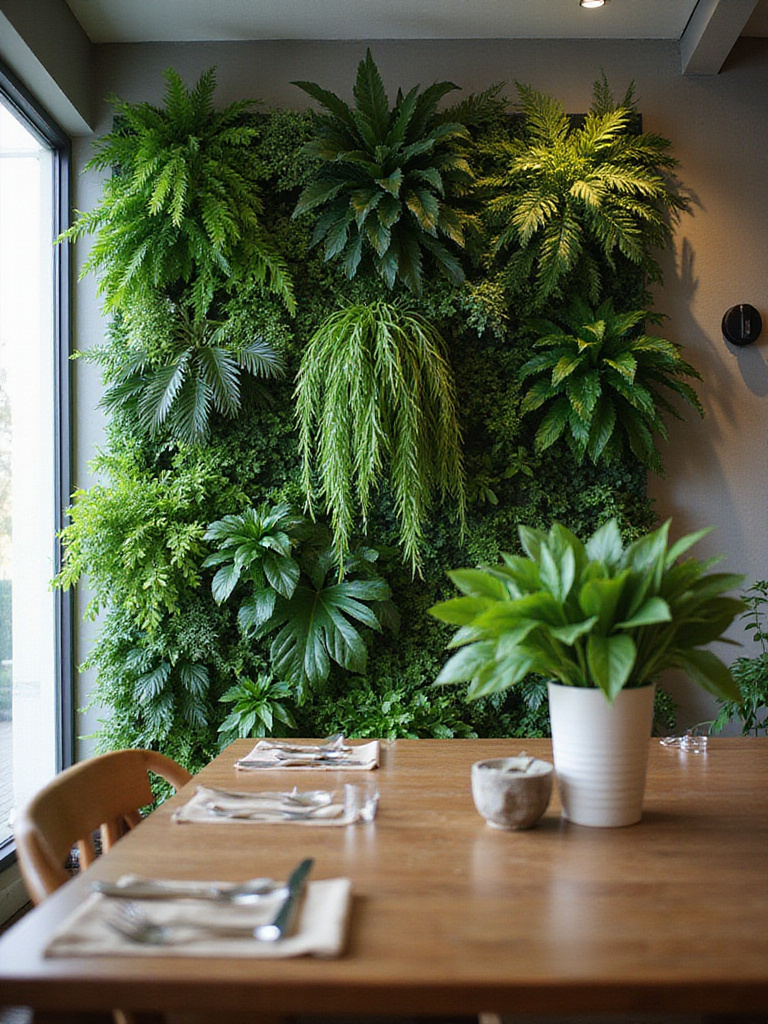
The success of a living plant wall depends on selecting appropriate plants for your dining room’s specific conditions. Consider the amount of natural light available, humidity levels, and temperature fluctuations when choosing plants. Low-light plants like pothos and philodendrons work well in dining rooms with limited natural light, while ferns and air plants thrive in more humid conditions.
- Air quality: Plants naturally filter toxins and improve indoor air
- Visual interest: Living walls change and evolve with the seasons
- Sensory appeal: Adds natural scents and gentle movement
The sustainable journey of this material involves selecting plants that thrive in your specific conditions while choosing growing systems that minimize water waste and maintenance requirements.
19. Create Luxury with Recessed Display Niches
Recessed display niches add architectural sophistication to your dining room while providing elegant display opportunities for your most treasured objects. These built-in alcoves create depth and visual interest in flat walls while offering a refined way to showcase artwork, ceramics, or other decorative pieces. The clean lines and precise proportions of well-designed niches add a custom, high-end appearance that elevates your entire dining room.

The size and proportions of your display niches should relate to both the objects you plan to display and your dining room’s overall scale. Multiple smaller niches can create a gallery-like effect, while a single large niche makes a bold architectural statement. Consider incorporating lighting within your niches to highlight displayed objects and create dramatic visual effects, especially during evening dining.
The finishing details of your niches—whether painted to match the wall or finished in contrasting materials—significantly affect their visual impact. Subtle contrasts create sophisticated depth, while bold contrasts make the niches themselves into decorative features. This level of customization ensures your niches enhance your dining room’s unique character.
Conclusion
Your dining room walls hold immense potential to transform not just the appearance of your space, but the entire experience of gathering around your table. Through these 19 dining room wall ideas, we’ve explored approaches that range from simple paint transformations to sophisticated architectural details, each offering its own unique way to enhance your dining environment.
The beauty of thoughtful wall treatments lies in their ability to create atmosphere and personality while serving practical functions. Whether you choose the warmth of natural shiplap, the drama of an oversized art piece, or the functionality of built-in storage, each approach contributes to making your dining room a place where people want to linger and connect.
Remember that the most successful dining room wall ideas are those that reflect your personal style while enhancing the way you actually use your space. Start with one approach that resonates with you, and allow your dining room to evolve naturally over time. Your walls are waiting to tell your story—let them speak with the warmth, character, and sophistication that make every meal a celebration.
